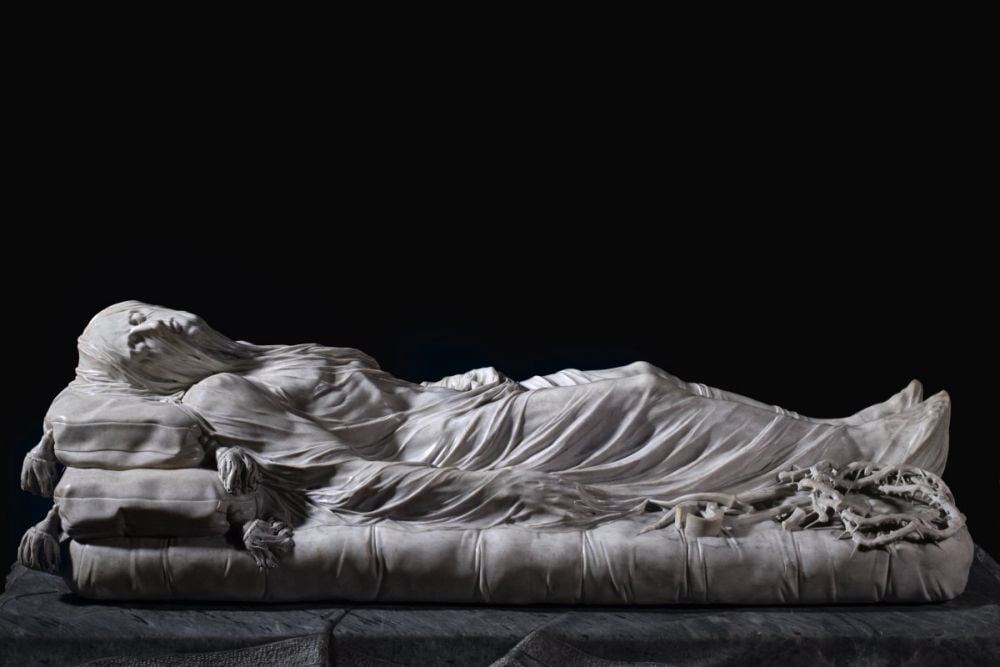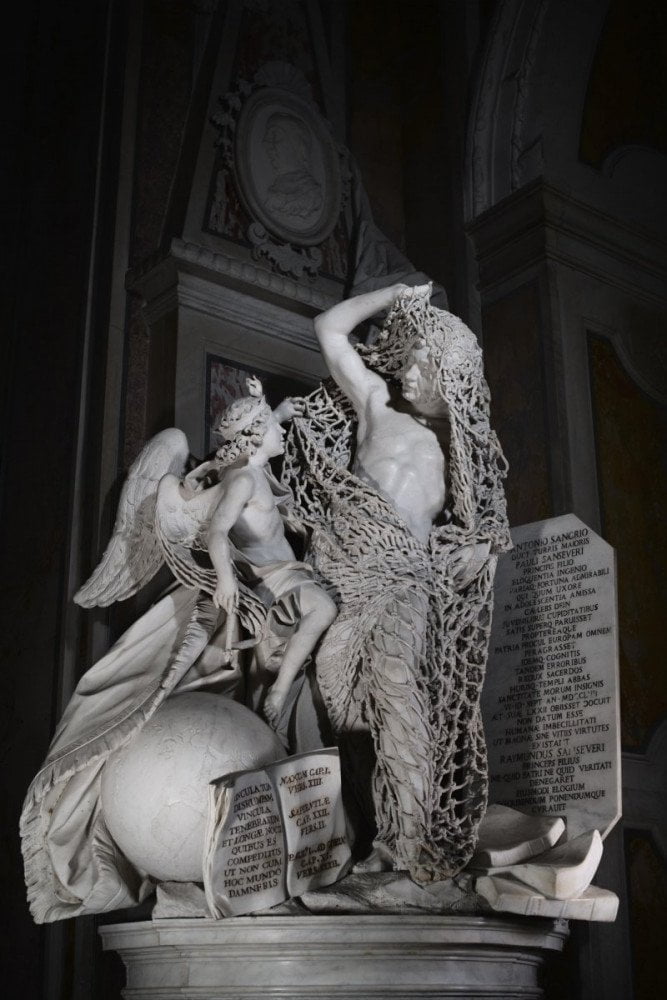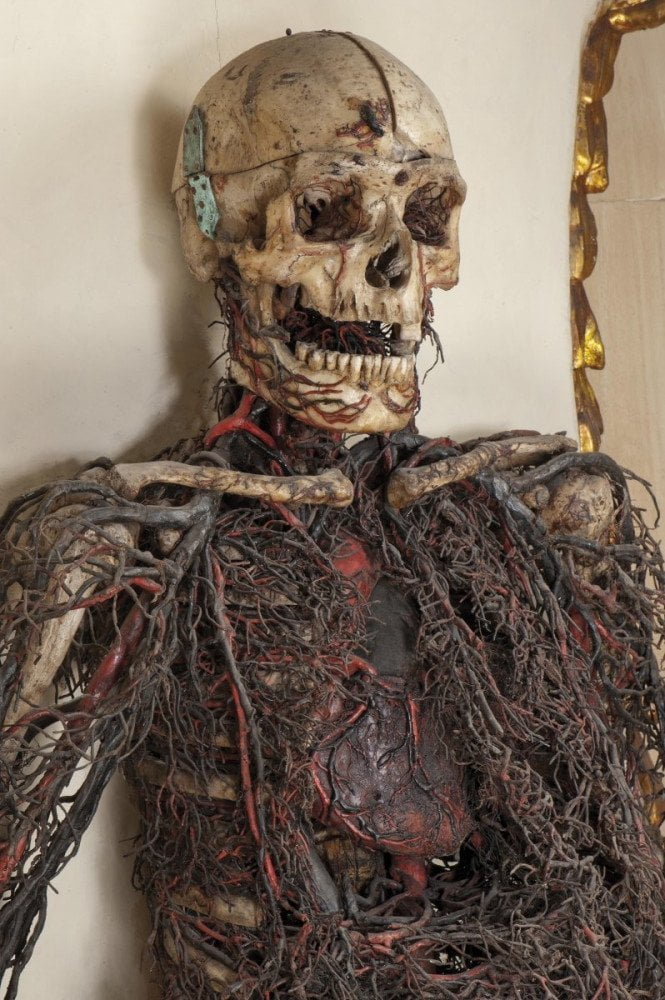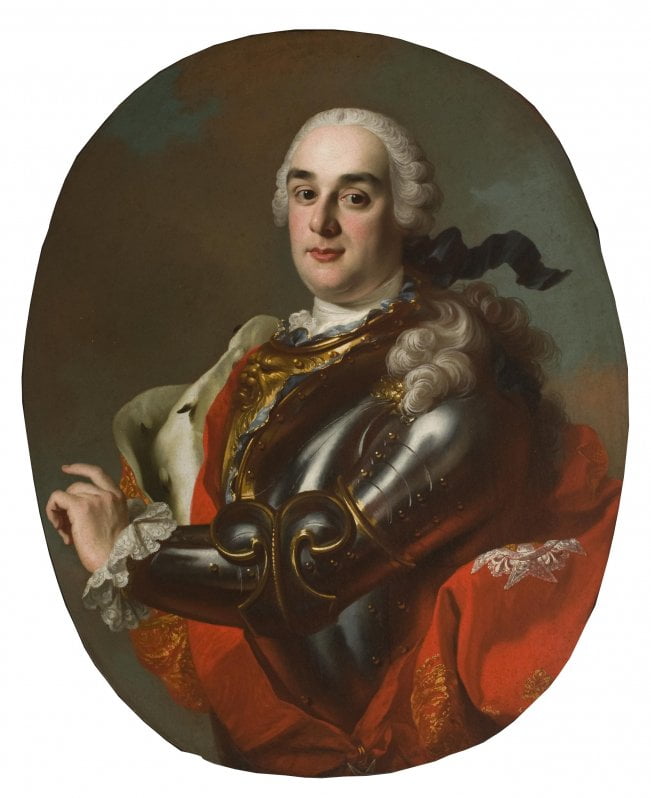The Sansevero Chapel, located in the historic centre of Naples, is a must-see attraction. Inside, visitors can admire the Veiled Christ statue, considered a masterpiece of sculpture. However, the chapel is also worth visiting for its unique combination of art and architecture hints at Freemasonry. Additionally, visitors can explore the crypt, where Prince Raimondo di Sangro’s curious anatomical machines are displayed.
Table of Contents
The Veiled Christ Statue in the Sansevero Chapel
The Sansevero Chapel is worth a visit for the Veiled Christ statue, sculpted by Giuseppe Sanmartino in the 18th century. This sculpture is considered a masterpiece because of its realistic shroud covering Christ’s body.
ORGANISE YOUR TRIP TO NAPLES
Save money on your trip to Naples with the Naples Pass and enjoy access to popular attractions like the underground city tour and the Catacombs of San Gennaro, along with unlimited public transport.
Stay connected throughout Italy by getting an Airalo eSim online for reliable data and phone coverage. Don’t forget to secure your Heymondo travel insurance for peace of mind and be covered for any surprises on your adventure!
The Veiled Christ statue shows the lifeless body of Christ with the crown of thorns and instruments of the Passion beside him. A veil leaning over him appears incredibly realistic. Despite rumours about the Christ’s shroud being made by an alchemical marbling process, it was actually carved from a single block of stone, as confirmed by contemporary analyses.
Antonio Canova, who unsuccessfully attempted to acquire the statue, declared that he would have given up ten years of his life to be able to create a work of art like this. The Marquis de Sade and composer Riccardo Muti praised its details and beauty. Aside from the Veiled Christ, the Sansevero Chapel contains other impressive statues, each with details that seem to come to life at every glance.

What to see in the Sansevero Chapel (besides the Veiled Christ)
The Sansevero Chapel boasts of several remarkable features, including the Veiled Christ. The chapel’s entire structure is impressively detailed, with statues that resemble real-life figures, intricate floors, and Christian figures adorned with hidden Masonic symbols. Additionally, the lower part of the church, known as the underground basement, houses two eerie anatomical machines that resemble exhibits from a Museum of Human Anatomy of Turin rather than belonging to a private collection.
The Masonic Statues representing the Virtues
The Sansevero Chapel houses ten statues representing the Virtues. They symbolise the spiritual journey of individuals who want to become Freemasons. To reach the truth, every new member must first perfect themselves. The most significant statues of the Virtues are Modesty and Disenchantment, which honour the mother and father of the Prince of Sansevero, Raimondo di Sangro.
Pudicity is a veiled woman who represents sensuality and stands next to a broken tombstone, signifying the impossibility of communication between life and death. It symbolises tragedy, depicting a life cut short too soon. The biblical scene of Magdalene attempting to touch the risen Jesus, with the same meaning, is on the pedestal, too.
Disenchantment portrays a man struggling to free himself from the web of deceit and sin. He stands next to a globe representing worldly passions from which he must liberate himself. The corresponding biblical scene on the pedestal is Jesus giving sight to a blind man, clearly referencing Masonic beliefs. The statue of Disillusionment is incredibly realistic, with even the net carved in marble.

The Deposition scultpure on the altar
The Deposition on the main altar in Naples is the only high relief sculpture on a central altar in Naples. This sculpture, created by Francesco Celebrano and Paolo Persico, contains no mystical or Masonic references. Instead, it portrays the classical figures of the Deposition.
In this sculpture, Mary and Magdalene, flanked by a series of angels and a child angel, show the metallic face of Christ imprinted on the shroud. The sculpture is incredibly realistic, with bodies, faces, and details carved in marble that seem to come to life.
Additionally, above the entrance door of the chapel, there is a sculpture depicting Cecco di Sangro emerging from a chest. This event happened during the battle to conquer the fortress of Amiens in Flanders when the nobleman had hidden himself to surprise his enemies.
The vault and the Masonic symbols in the Sansevero Chapel
The Sansevero Chapel is home to many sculptures, including the magnificent Veiled Christ statue. But that’s not all – the chapel’s ceiling is also a sight. The ceiling looks like an illusionistic architecture. Many architectural elements, including the people portrayed, are painted to look authentic.
The fresco on the vault is incredibly vivid and intense, thanks to a chemical formula invented by Raimondo di Sangro, Prince of Sansevero. The Prince was dissatisfied with the original painting by the painter Francesco Maria Russo. For this reason, in his will, he left a recommendation to redo the fresco completely.
The fresco has a substantial symbolic value, as it conceals Masonic symbols. The angels and other characters converge towards the scene’s centre, where a dove can be seen in a cloud, holding a triangle in its beak.
The triangle has multiple symbolic meanings. It represents the Catholic trinity and the Greek capital letter delta Δ, considered the symbol of cosmic birth by the Pythagoreans. In Freemasonry, the delta is the sign of the Worshipful Master, like Raimondo di Sangro, Prince of Sansevero, was.

The labyrinth floor of the Sansevero Chapel
The San Severo Chapel originally had a complex labyrinth inlay pattern on its floor, made of an unbroken line of white marble without any joints. Francesco Celebrano created this impressive work. Unfortunately, due to a collapse in 1889, only a few pieces of the original floor survived, one in front of Raimondo di Sangro’s tomb and the other in the underground basement.
The original design alternated swastikas and concentric squares arranged in perspective. The white marble had no joints and looked like a single inlaid slab. The unbroken marble line was yet another remarkable invention of the Prince of Sansevero.
Like all the works of art in the Sansevero Chapel, the floor also has a Masonic meaning. The labyrinth represented the alchemic image of the Great Work and the initiate’s difficulty in arriving at Knowledge.
The underground basement and the anatomical machines
Below the Sansevero Chapel lies the underground basement. It is a small room, much smaller than it looks in the photos. Raimondo di Sangro originally intended this room to serve as a burial site for his descendants and as a display area for the Veiled Christ statue, illuminated by lamps with perpetual light that he had invented.
However, today, the basement houses the anatomical machines created by Giuseppe Salerno. They are two skeletons, one of a man and the other of a woman, with their circulatory systems exposed.

The anatomical machines were initially located in the Apartment of the Phoenix, the residence of Raimondo di Sangro. They were later moved to the cavea of the Sansevero Chapel to protect them from being dispersed or destroyed after the Prince’s death.
The Prince was known for his interest in alchemy, and this led to the spread of a legend that the machines were two of his servants who had been killed and put on display. However, the truth is that the male anatomical machine was purchased in 1756 after an exhibition in Naples, while the female machine was made later upon his commission.
These machines had the sole purpose of studying the human body and its anatomy. They were both made by the Sicilian doctor Giuseppe Salerno. The circulatory system of the anatomical machines in the Sansevero Chapel is composed of various materials, including dyes and beeswax. There is nothing alchemical or inexplicable about them. The only mystery surrounding these machines is the disappearance of the foetus, initially displayed at the woman’s feet and later stolen in the mid-20th century.
Raimondo di Sangro Prince of Sansevero: inventor, writer, esotericist
Prince Raimondo di Sangro lived in Naples in the 18th century. He had many interests and pursuits, which included being a nobleman, military man, inventor, esotericist, anatomist, alchemist, patron of the arts, freemason, and writer. His activities often gave rise to many popular legends.
Benedetto Croce famously called him the “Neapolitan incarnation of Doctor Faust,” who made a pact with the devil to master nature’s innermost secrets and became a quasi-devil himself. Rumours said that he had killed seven cardinals to make chairs out of their bones and blinded Giuseppe Sanmartino to prevent him from recreating the Veiled Christ.
However, Raimondo di Sangro was merely an experimenter in various scientific fields. His results appeared prodigious and inexplicable to his contemporaries. The inscription on his tombstone, which he had engraved using his own invented process, describes him as an “extraordinary man predisposed to all the things he dared to undertake (…) celebrated investigator of the most recondite mysteries of Nature.”
The inventions of Raimondo di Sangro
The Prince of Sansevero, Raimondo di Sangro, made significant contributions to the technological advancements of his time. He was a prolific inventor, creating numerous devices. Some of them are: a folding stage for theatrical performances, an arquebus that could function with both powder and compressed air, a light cannon with an extended range, a paddle-operated sea carriage, several medicines, a system for colouring glass, an artificial gem-making process, pyrotechnic fires of different colours, a substance that could burn for three months continuously, which he intended to use to illuminate the Veiled Christ, a hydraulic machine to divert the flow of water, and a method of printing in colour.
The disagreements with the Catholic Church
In his infinite thirst for knowledge, Raimondo di Sangro also attempted to reproduce the miracle of San Gennaro’s blood, attracting the Church’s wrath. His most famous book, the Lettera Apologetica was included in the Index librorum prohibitorum, or Index of Forbidden Books of the Catholic Church, a list only suppressed in 1966.

Practical information for visiting the Sansevero Chapel in Naples
The Sansevero Chapel, home to the famous Veiled Christ, still belongs to the descendants of Raimondo di Sangro, Prince of Sansevero, but is open to the public.
Despite its small size, the Chapel is rich in detail, so I recommend a visit of at least an hour. While some visitors have reported spending just a few minutes inside, others have taken over an hour to appreciate the works on display fully. Personally, I spent an entire hour listening to the audio guide. The audio guide lasts around 25 minutes, but you can pause and replay it.
Photography is not permitted inside to protect the Chapel’s artistic heritage, including the Veiled Christ. As such, the images in this article came from the official museum website.
How to buy tickets and book your visit
The Sansevero Chapel is a top-rated attraction for tourists in Naples. Given its small size, there is a limit to the number of people who can be admitted daily and at the same time. For this reason, without booking in advance, the ticket office did not guarantee the availability of tickets despite the long queue.
Without booking online, you could get a ticket at the ticket office. Still, they sell only residual tickets and do not guarantee access to the Sansevero Chapel. The single entrance ticket costs € 8 + booking fee, while the audio guide, strongly recommended if you are not visiting the building with a guide, costs € 3.50 + booking fee.
At the time of writing, you can get online tickets from the Sansevero Chapel website one month in advance. Still, you can book tours earlier. To ensure getting tickets, you can book a guided tour of Naples with the Sansevero Chapel. Check the calendar below for the available dates.
How to get to the Sansevero Chapel
The Sansevero Chapel is in the historic centre of Naples, behind Piazza San Domenico Maggiore. You can get to the Chapel on foot if you are in the centre. Otherwise, you can take the metro. The nearest stops are Università and Dante on Line 1 and Cavour on Line 2.
Museo Cappella Sansevero
Via Francesco de Sanctis, 19/21
80134 Napoli
Where to stay in Naples
Naples boasts numerous accommodations, from hotels to seaside flats. With my frequent visits to Naples, I can suggest several options. For an authentic experience in the historic center, consider The Idyll Boutique Apartment in the Spanish Quarter. This charming flat features parquet floors and a fully equipped kitchen, conveniently close to major attractions. Alternatively, the upscale Relais Della Porta, situated on Via Toledo, places you a short distance from landmarks like the San Carlo Theatre. Last but not least, the Santa Chiara Boutique Hotel, located near the Dante metro stop, offers a continental or Italian breakfast to start your day.
The Sansevero Chapel is incredible not only because of the Veiled Christ but also because it is an authentic work of art. The sculptures, the labyrinth-like floor and the fresco on the ceiling will leave you speechless. Feel free to share your thoughts about the Veiled Christ and the Sansevero Chapel in the comments.
